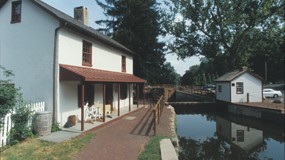A FIELD GUIDE TO THE BUTTERFLIES OF THE DELAWARE CANAL REGION
Our photographers have recently focused on capturing the flitting beauty of the many species of butterflies in our area. According to the Penn State Extension, 146 species of butterflies have been sighted in our state; however, some are rare or infrequent visitors. If you add moths to the equation, the number grows to over 500.
In the summer, volunteers from several nature groups conduct butterfly counts to determine the health and diversity of the butterfly population.
It takes a keen eye and a calm hand to capture these engaging insects in a photograph. Some butterflies, like the very common cabbage white, have wingspans of less than 2”, while others, like the eastern tiger swallowtail, have wingspans of over 5”. There are many online resources that provide lists of the top butterfly populations in Eastern Pennsylvania. Here we will focus on some of the species recorded by Carole Mebus in the northern part of the county and Judy Greger in the central region.
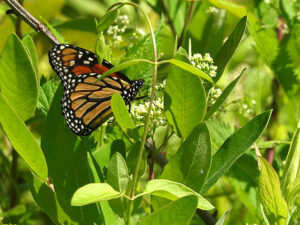
Monarch Butterfly: One of summer’s most long-awaited sightings is the Monarch butterfly. It is known for its migratory journey to and from Mexico, which spans several generations. Monarchs rely on the milkweed plant both as caterpillars and as adults. In fact, the milkweed plant is the only plant on which the Monarch will lay its eggs. Populations have declined due to habitat loss, pesticide use, and loss of milkweed. So, if you love this colorful, medium-sized beauty, be sure to plant milkweed in your garden.
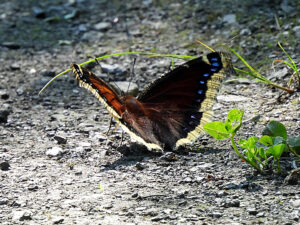
Mourning Cloak: This butterfly’s black-brown mournful color is noticeable only when its wings are closed. It is unique as it can withstand the winters in our area as an adult. Nestled in tree crevices and other protected spots, it can hibernate until the warmer spring weather returns. It uses many local tree species, including willow, elm and mulberry, as host plants for its eggs.
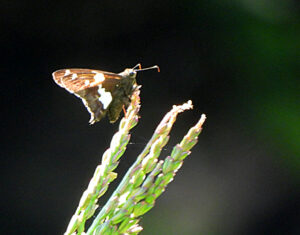
Silver-Spotted Skipper: This small and lively butterfly is found around most blooming garden plants. It is very adaptable to changing environments and diets, making it one of the most common butterflies in our area.
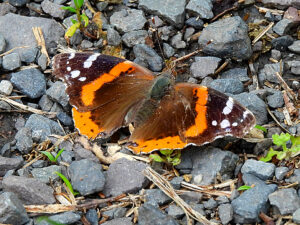
Red Admiral: With a wingspan of up to 3”, this butterfly is easy to spot as it is very calm, allowing the observer to take time to admire its beauty. Admirals can be found wicking nutrients from muddy pools and puddles.
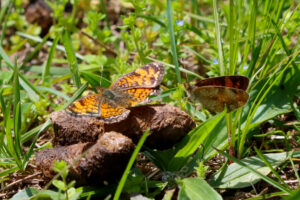
Pearl Crescent: This small, nectar-loving butterfly is common in our area. They produce several broods from April to November. Their name comes from a pearly-white marking on the underside of the wing.
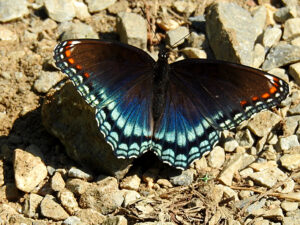
Red-Spotted Purple: With a wingspan of up to 4”, this fairly rare butterfly prefers tree sap and rotting fruit to flower nectar. They use native trees such as cottonwood, willows, black oak and host plants for their larvae. Its coloration mimics the Pipevine Swallowtail, an unpleasant-tasting insect that predators avoid.
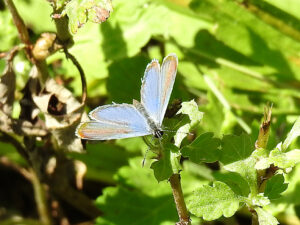
Eastern Tailed-Blue: This diminutive butterfly tends to stay close to the ground and can be found feasting on clover, wild strawberries and aster, the same plants that act as hosts for the caterpillars. It gets its name from a small tail on the hindwing.
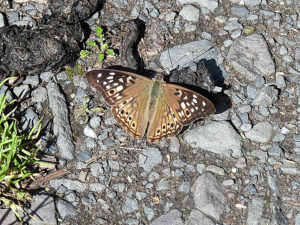
Hackberry Emperor: The Hackberry Emperor, named for the tree where it lays its eggs, doesn’t compete with other butterflies for flower nectar but has an unusual diet of tree sap, feces and even dead animals.
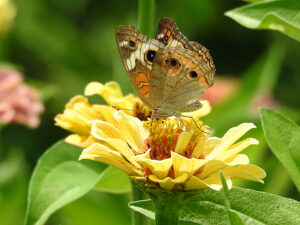
Common Buckeye: The Common Buckeye has a wingspan of 1.5–2”. Named for the target-shaped eyespots on the wings, this sun lover can be found in fields, gardens, parks, and roadsides. The common plantain is one of the host plants for the larvae.
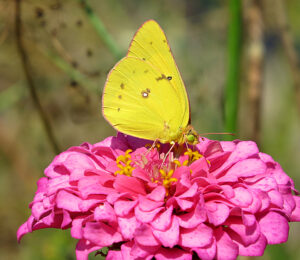
Orange Sulfur: This widespread medium-sized butterfly, is a nectar lover that enjoys a wide variety of flowering plants. When abundant, the orange sulfur caterpillars can devastate crops such as peas and alfalfa. Farms faced with an infestation use a parasitoid wasp to control the caterpillars.

Great Spangled Fritillary: A medium-sized butterfly with a wingspan of 2-3 inches, the orange and black markings make this butterfly easy to distinguish. The butterfly’s diet includes coneflowers, thistle, milkweed and clover. The larvae feed on violas, a species of violets.
Butterflies and their recorded numbers in our area are vital indicators of the health of our region and the planet. When encountering one of these natural marvels, remember that you can enhance their habitat by adding a host plant to your landscape, attracting more of your favorites year after year.
Of course, we must recognize and thank our two photographers and Friends, Carole Mebus and Judy Greger, for a steady supply of captivating photographs.
Sources: Pennlive.com, Butterfliesandmoths.org, Butterflyidentification.org, Wikipedia.
